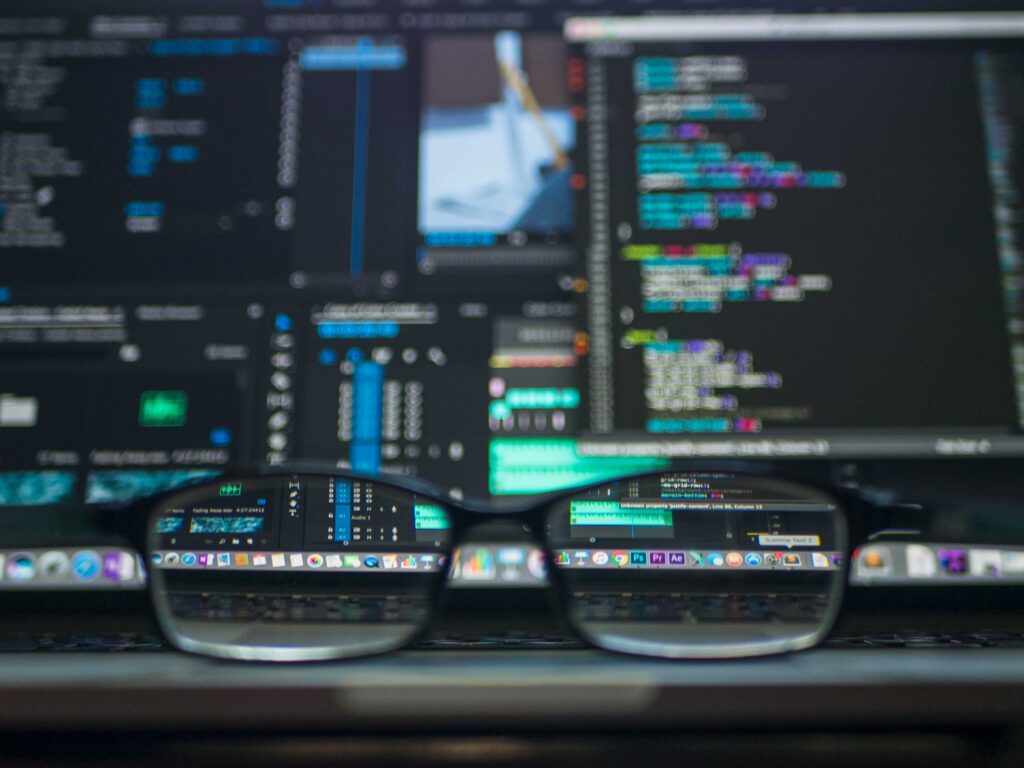A Beginner’s Guide to Data Science
- Tony Camme
- July 17, 2023

The era of big data is here. It has revolutionized how organizations make critical decisions and have changed the way businesses are run for good. With big data dominating the digital age, the need for data scientists is now greater than ever.
Sometimes called the “sexiest job of the 21st century,” demand for data scientists has reached unprecedented levels and shows no signs of slowing down anytime soon.
In our data-driven world, the only way to remain relevant and competitive is to learn skills that will propel you into the future. Data science is a great place to start. Let’s take a look at what data science is, what data scientists do, and, importantly, how to become one today.
What is Data Science?
Before we get into the details, let’s define data science. Simply put, data science involves collecting and analyzing large amounts of data to extract insights and knowledge for specific purposes.
Typically, data scientists will use advanced statistical methods, machine learning techniques, and computational skills in order to turn data into actionable insights.
These insights are integral; they can show patterns that might not otherwise be obvious, which helps inform decision-making, solve complex problems, and drive innovation. Any industry where large volumes of data are collected on users – like finance, healthcare, or technology – need data scientists to make sense of what is collected.
Data scientists help organizations make more informed decisions, improve overall efficiency, and drive growth and innovation. In our data-driven world, they are essential.
The Circle of Life (for Data)
There is a tried and tested process that data scientists follow that helps them to pluck out insights from data. The data science life cycle consists of several stages that typically take months to complete.
To start, a data scientist must define the problem at hand, working with stakeholders to identify exactly what they will use data to resolve, and then establishing success metrics. After that, they will collect the data and scrub it clean of any errors or inconsistencies. It is then ready for analysis.
The next step involves data analysis and data modeling. In this stage, data scientists will use statistical and machine learning techniques to explore the data, identify patterns, and build models to make predictions and set the business on the right course.
Finally, the results are communicated to stakeholders using data visualizations that are easy to understand. From there, a data scientist will then make recommendations to stakeholders about the best way forward.
Data Science Techniques
Data scientists employ many different specialized techniques to analyze and interpret large sets of data. Three of the most common techniques include classification, regression, and clustering. Let’s explore them here:
- Classification is the process of grouping data into predefined categories or classes. This is typically used to predict outcomes or to identify patterns in data where the classes are already known. Overall, this process makes data easier to locate and retrieve, and also helps keep the data safe and secure.
- Regression is used to predict numerical values based on input data. With this analysis, the relationship between an independent and dependent variable are explored in order to make predictions about the data. This helps with data that has continuous numbers in industries like finance, automobile testing, and weather analysis.
- Clustering helps to identify natural groupings within data that might not otherwise be apparent to the human eye. This technique involves identifying patterns and relationships within the data to group similar data points together.
These techniques are among many that most data scientists keep in their toolkit. Learning to select the right method for a given task is essential to drawing accurate insights and making predictions using data.
Data Science Technologies
Without powerful tech, data science would be a tedious – and nearly impossible – feat. Nowadays, data scientists use a wide range of tools, frameworks, and platforms to collect, analyze, and interpret data. Thanks to advances in technology, we no longer have to rely on our own human brains to do all the work.
These tools help data scientists process data quicker, do more advanced analysis, and help them develop models to better communicate their findings. Some of these key technologies include:
- Artificial Intelligence (AI): AI involves the development of intelligent systems that can perform tasks autonomously that would otherwise require human input. This field employs machine learning, natural language processing, computer vision, and other techniques. These processes help computers learn from data, make predictions, and automate complex processes.
- Cloud Computing: Rather than storing computing services on centralized servers, cloud computing allows for computing services to be delivered over the internet (or “the cloud”). With cloud computing, data scientists can have on-demand access to a shared pool of computing resources, like storage, servers, and databases. Cloud platforms offer scalability and are very cost-effective, making them popular for storing and processing large amounts of data in data science applications.
- Internet of Things (IoT): The IoT is the network of physical devices, sensors, and software that are connected to each other. They collect and exchange data in order to enable the integration of physical objects (like smartphones) into digital systems (the internet). This exchange between physical and digital creates opportunities for data collection, analysis, and automation. Data scientists often use the IoT for predictive maintenance, real-time monitoring, and optimization of various processes.
- Quantum Computing: Using the principles of quantum physics, quantum computers can carry out larger computations more quickly than traditional computers. Data scientists leverage this computing power to enhance optimization algorithms, to analyze large datasets at a faster pace, and to contribute to advancements in machine learning and cryptography.

What is Data Science Used For?
The mark of a skilled data scientist is their unique ability to not only understand how to analyze data but exactly what questions to ask in the first place. They are also able to gather data from a wide array of sources, know how to structure information, translate their findings into solutions, and effectively communicate these insights, too.
These sills are in high demand across many different industries – not just tech – making trained data scientists increasingly indispensable to all companies that deal with data.
In healthcare, for example, data scientists can draw out specific information to help doctors or hospitals make decisions based on that information. Rather than relying on a doctor to store knowledge in their brain, a data scientist can use data to create personalized treatment plans for patients or create guidelines for disease prediction.
In broad strokes, data scientists help organizations understand consumer behavior by detecting patterns in order to improve overall operations.
Data science also powers recommendation systems (like movie recommendations on Netflix), virtual assistants (like Siri), and self-driving cars (like Tesla). By leveraging mathematics, statistics, and programming, data science unlocks the value hidden within data in order to create a better, more informed, more efficient world.

What Does a Data Scientist Do?
In order to extract insights and knowledge from complex datasets, data scientists need to understand how to use specific statistical and machine learning techniques. On your journey to becoming a data scientist, here are some of the key skills, tools, and programs you will learn to master:
Key skills of a data scientist
In terms of hard skills, data scientists need to have a strong foundation in mathematics and statistics. They also need to learn fluency in programming languages like Python or R. Proficiency in data manipulation, data visualization, and machine learning algorithms is also essential for effective and efficient data science work.
Soft skills are equally as important. Effective communication skills help data scientists convey complex findings and insights to non-technical stakeholders. The ability to problem-solve is also key when they are asked to tackle intricate data challenges that require innovative solutions.
When you train to become a data scientist, you must learn to harness your critical thinking skills to approach difficult problems from multiple perspectives in order to derive unique and meaningful insights. You will need to work collaboratively with a team to action those insights, and also learn to be adaptable to the ever-evolving data science landscape.
In essence, a data scientist is curious and result-oriented. They possess exceptional, industry-specific knowledge and supreme communication skills that help turn their insights into action.
Tools & programs data scientists use
Data scientists use many tools and programs to help them in their analysis. These include:
- Programming languages: Data scientists use languages like Python and R, which provide extensive libraries and frameworks for data analysis, statistical modeling, and machine learning. Using programming languages helps data scientists manipulate, clean, and process data efficiently.
- Data manipulation and analysis tools: Tools in Python and R help facilitate data manipulation, transformation, and exploratory data analysis. They offer functionalities for filtering, sorting, aggregating, and joining datasets.
- Data visualization: Using tools like Matplotlib, Seaborn, and ggplot2, data scientists can create visual representations of their data findings. These libraries help generate graphs, charts, and plots that help illustrate patterns, trends, and relationships in data.
- Machine learning libraries: Libraries like TensorFlow and PyTorch help data scientists develop and implement predictive models. They provide a wide range of algorithms and tools for tasks like classification, regression, clustering, and deep learning.
- Structured Query Language (SQL): Data scientists use SQL to work with relational databases. They use it to extract, transform, and analyze data stored in databases, helping them perform complex queries and aggregations.
- Big data frameworks: To work with big data, data scientists use tools like Apache Hadoop and Apache Shark to manipulate large datasets. These frameworks enable distributed processing, which makes it more feasible to work with massive volumes of data across clusters of computers.
- Cloud platforms: These include Amazon Web Services (AWS), Microsoft Azure, and Google Cloud Platform. They offer a wide range of services for data storage, processing, and analysis using cloud computing technologies.
- Data Science Integrated Development Environments (IDEs): These include programs like Jupyter Notebook and RStudio. They provide an interactive environment for data exploration, experimentation, and documentation. By combining code, data visualizations, and explanatory text, they make it easier to share and collaborate on data science projects.
How to Become a Data Scientist
It may seem like a daunting feat to become a data scientist. Unlike many other professions, however, you don’t necessarily need a university-level degree to be a successful and powerful data scientist. There are online certifications and courses you can enroll in that can help you learn the necessary skills to break into the data science field in no time at all.
Here are some ways you can do it:
Enroll in an online course
With online training, it is easier than ever to upskill or reskill into a new career trajectory with the right online certification. Look out for reputable institutions and platforms that offer comprehensive curricula, hands-on projects, and experienced tutors.
ALX Global is a great example of this. We provide online tech education made for the future, with a rigorous, industry-aligned curriculum that covers essential data science concepts and practical skills.
The Data Science Program is an 11-month online course that you can complete on your own time. It is designed specifically to train learners to be job-ready by the time they gain their certification. There is no prerequisite knowledge required either – it truly is for anyone who wants to work towards becoming a data scientist.
You can enroll today – registration for our next cohort ends on the 21st of August.
Sharpen your skills
If you already work in tech or have taken some data science courses already, there are some ways you can keep yourself competitive in the job market. There are some technical and soft skills that are requirements for any data scientist that you can spend time sharpening and enhancing.
Some of these skills, softwares, and tools include:
- Programming languages like Python, R, SQL, and SAS
- Data Visualization software like Tableau, PowerBI, and Excel
- Machine learning concepts
- Big data concepts
- Communication skills
Apply for entry level jobs
If you’ve gotten a certification and have sharpened your skills, you’re ready to start applying to jobs. Some potential entry-level data science jobs that you could apply for include:
- Data analyst – You will be responsible for collecting, clearing, and analyzing data to extract insights and support decision-making processes.
- Data engineer – You will focus on designing and building data pipelines and infrastructure to support data processing, storage, and retrieval.
- Junior data scientist – This role focuses on data analysis, modeling, and machine learning projects under the guidance of a senior data scientist.
- Business intelligence analyst – You would be responsible for analyzing data and providing insights that you will use to make recommendations that will improve business performance.
- Research assistant – These roles generally exist in academia or research institutions, like universities. You would assist in data collection, analysis, and interpretation of various data-related projects.
- Data visualization specialist – In this role, you would focus on creating compelling and informative visualizations to present data and insights
Overall, entry-level positions vary across industries and organizations. Specific job titles and responsibilities will vary depending on what the company you are applying to needs. One of the best things you can do is to build a strong portfolio of projects and build a network of data science professionals using a platform like LinkedIn.

Future-Proof Your Career with Data Science Training
As the digital world becomes more and more data-driven, data science finds useful applications in both tech and non-tech fields. In the tech industry, data science plays a crucial role in areas such as:
- AI and Machine Learning
- Data-driven decision-making
- Cybersecurity
Data-driven insights and decision-making are increasingly becoming the norm across industries, too. Data scientists are no longer only relegated to the tech industry. Some non-tech fields that data science also has transformative applications, including:
- Healthcare: Data science enables highly-personalized medicine, helping doctors with anything from predicting disease outbreaks to analyzing medical imaging data and improving patient outcomes overall. Using data science principles, patterns and trends can be identified in large-scale healthcare data, leading to more accurate diagnoses, more effective treatments, and better public health strategies.
- Finance: From fraud detection to risk assessment and algorithmic trading to investment portfolio optimization, data science has been revolutionizing finance, too. Data scientists can analyze large volumes of financial data to uncover patterns and signals that inform investment decisions and mitigate financial risks.
- Transportation & Logistics: Data scientists can optimize transportation routes, predict product demand, help reduce fuel consumption, and improve supply chain efficiency.
Summary
As the application of data continues to grow in both volume and complexity, the demand for skilled data scientists is sure to increase. By embracing data science, individuals can navigate the data-driven landscape of our digital world, extract meaningful insights, and make informed decisions that drive impactful outcomes.
With continuous learning and adaptation to new technologies and techniques, aspiring data scientists can embark on a fulfilling and rewarding career in this dynamic field.
To future-proof your career and equip yourself with necessary data science skills, consider enrolling in ALX Global’s Data Science program, today!
FAQs
What is data science in simple words?
Data science is a field that involves collecting, analysing, and interpreting large amounts of data to uncover meaningful patterns, insights, and knowledge. It combines elements of statistics, mathematics, and computer science to make sense of complex data and extract valuable information that can be used for decision-making and problem-solving.
Data science helps us understand the world better by unlocking the hidden stories and trends hidden within data.
What is the role of a data scientist?
The role of a data scientist is to analyse and interpret complex data sets to derive valuable insights and inform decision-making processes. They employ statistical techniques, machine learning algorithms, and programming skills to extract meaningful patterns, trends, and correlations from data.
Data scientists also play a crucial role in developing predictive models, designing experiments, and communicating their findings to stakeholders in a clear and actionable manner. Their work is vital in helping organisations make data-driven decisions and gain a competitive edge.
What skills do data scientists need?
Data scientists need a combination of technical and soft skills. Technical skills include proficiency in programming languages like Python or R, knowledge of statistical analysis and machine learning algorithms, data manipulation and visualisation, and database querying with SQL.
They also need strong analytical and problem-solving abilities, as well as the ability to interpret and communicate complex findings effectively. Additionally, data scientists should possess critical thinking, curiosity, and a continuous learning mindset to stay updated with emerging technologies and advancements in the field.